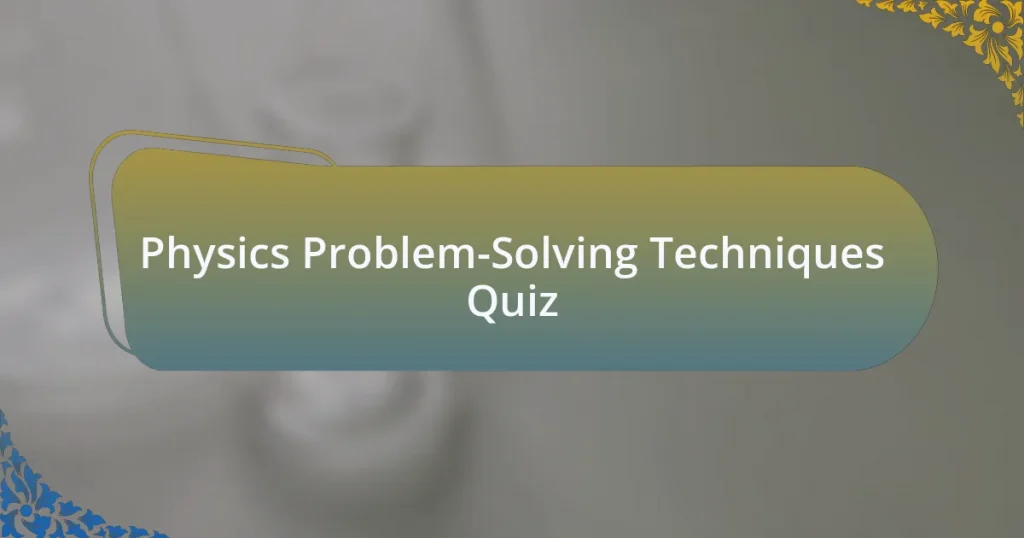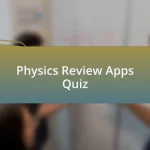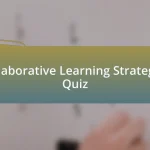Start of Physics Problem-Solving Techniques Quiz
1. What is the initial step in applying the GUESS method for physics problem-solving?
- Analyze the given data without a clear question.
- Identify what you have been asked to solve.
- Calculate the answers before knowing the question.
- State assumptions without understanding the problem.
2. In the GUESS method, which step involves creating a clear visualization of the problem?
- Identify relevant equations.
- Analyze data thoroughly.
- Visualize the problem clearly.
- Summarize the solution succinctly.
3. What is the standard unit of electric charge in the International System of Units?
- Ohm
- Volt
- Ampere
- Coulomb
4. Who developed the famous theories related to general relativity and gravity?
- Isaac Newton
- Albert Einstein
- Niels Bohr
- Galileo Galilei
5. What is the standard unit used to measure force in physics?
- Joule
- Watt
- Newton
- Pound
6. On Earth, what is the value of acceleration due to gravity typically used in calculations?
- 8.5 meters per second squared
- 9.0 meters per second squared
- 10.0 meters per second squared
- 9.8 meters per second squared
7. Which physical quantity is considered a vector because it includes both magnitude and direction?
- Velocity
- Distance
- Mass
- Speed
8. What term describes the energy an object possesses due to its motion?
- Kinetic energy
- Chemical energy
- Thermal energy
- Potential energy
9. What is the term for the bending of light waves as they transition between different media?
- Dispersion
- Reflection
- Refraction
- Diffraction
10. Identify one common example of a simple machine used in everyday life.
- Lever
- Wheel
- Battery
- Circuit
11. What do we call the process in which a substance changes from solid directly to gas?
- Freezing
- Evaporation
- Sublimation
- Melting
12. What is the SI unit for measuring electric current?
- Volt
- Ohm
- Coulomb
- Ampere
13. What type of energy is associated with an object`s position relative to other objects?
- Nuclear energy
- Potential energy
- Thermal energy
- Kinetic energy
14. What force acts against the movement of an object through a fluid?
- Tension
- Drag force
- Compression
- Gravity
15. Who is recognized as the pioneer of classical mechanics through his laws of motion?
- Niels Bohr
- Albert Einstein
- Isaac Newton
- Galileo Galilei
16. What unit is used to quantify electrical resistance in a circuit?
- Ampere
- Joule
- Volt
- Ohm
17. What measurement unit is used to denote frequency in physics?
- Newton
- Hertz
- Joule
- Volt
18. What type of lens is known for being thicker in the middle than at the edges?
- Diverging lens
- Convex lens
- Flat lens
- Concave lens
19. What field of study focuses on the properties and behaviors of light?
- Magnetism
- Optics
- Geophysics
- Thermodynamics
20. What is the term for the phase change when a gas turns into a liquid?
- Sublimation
- Vaporization
- Condensation
- Evaporation
21. How is power defined in the context of physics?
- Power is defined as the rate at which work is done or energy is transferred.
- Power is the mass of an object times its velocity.
- Power is the speed of an object in motion.
- Power is the total energy stored in a system.
22. What is the name given to the force that binds atomic components together?
- Gravitational force
- Frictional force
- Strong nuclear force
- Electromagnetic force
23. How is the unit of electric potential difference referred to in physics?
- Ampere
- Volt
- Ohm
- Joule
24. Which astronomer is noted for his laws governing planetary motion?
- Nicolaus Copernicus
- Johannes Kepler
- Tycho Brahe
- Galileo Galilei
25. According to the GUESS method, what is the concluding step of the problem-solving process?
- The final step involves formulating mathematical equations.
- The final step of the GUESS problem-solving process involves checking your solution.
- The final step involves identifying key variables.
- The final step involves drawing a diagram of your solution.
26. Why is it important to create a free body diagram when solving physics problems involving forces?
- To visualize and analyze the forces acting on an object.
- To create a summary of the physics equations used.
- To determine the speed of the object in motion.
- To calculate the total energy of the system.
27. What is the method to ascertain the direction of an induced current in a conducting rod?
- Count the number of magnetic field lines.
- Use the right-hand rule.
- Measure the length of the rod.
- Calculate the resistance of the rod.
28. What effect does adding cold cream to hot coffee have on its temperature?
- The temperature of the coffee remains the same.
- The temperature of the coffee fluctuates wildly.
- The temperature of the coffee increases.
- The temperature of the coffee decreases.
29. Which equation is used to derive the acceleration due to gravity on various celestial bodies?
- \( E = mc^2 \)
- \( P = \frac{W}{t} \)
- \( g = \frac{G \cdot M}{r^2} \)
- \( F = ma \)
30. Describe the principle of conservation of momentum in relation to closed systems.
- The total energy of a closed system is always equal to zero.
- The total momentum of a closed system remains constant over time.
- The momentum can increase if external forces act on the system.
- The momentum of each individual object in a closed system is constant.
Quiz Completed Successfully!
Congratulations on finishing the quiz on Physics Problem-Solving Techniques! Your engagement shows your commitment to mastering essential strategies in physics. Understanding these techniques can greatly enhance your analytical skills, making it easier to tackle even the most challenging problems. You may have learned how to identify key variables, organize information effectively, and apply mathematical principles with confidence.
As you navigated through the questions, you likely discovered various approaches to solve problems, such as breaking down complex issues into simpler parts, utilizing diagrams, and applying relevant formulas. Each of these techniques is pivotal in building a solid foundation for your future studies and exams. The more you practice, the more adept you will become at applying these methods under pressure, which is crucial for success in physics tests.
We invite you to delve deeper into the topic by exploring the next section on this page dedicated to Physics Problem-Solving Techniques. This resource is specially designed to expand your knowledge and provide further insights. Embrace this opportunity to strengthen your grasp on essential concepts that will not only prepare you for exams but also cultivate a genuine appreciation for the world of physics.
Physics Problem-Solving Techniques
Understanding the Fundamentals of Physics Problem-Solving
Physics problem-solving begins with a firm grasp of fundamental concepts. This understanding allows students to relate abstract theories to real-world situations. Familiarity with core principles like Newton’s laws, thermodynamics, and electromagnetism is crucial. Mastering these foundational topics enhances analytical thinking, aiding in the breakdown of complex problems into manageable parts. A solid foundation fosters confidence and accuracy in solving physics problems effectively.
Identifying Key Variables in Physics Problems
Identifying key variables is essential in physics problem-solving. This involves pinpointing the parameters that affect the situation at hand. Variables can include mass, velocity, force, and energy, among others. Recognizing which variables are relevant simplifies the problem significantly. It allows for the use of appropriate equations to derive solutions. This step is critical for accurate calculations and helps avoid common errors that can arise from overlooking crucial elements.
Applying Appropriate Physics Formulas
Applying the correct formulas is a crucial technique in physics problem-solving. Each physics discipline has specific equations governing its principles, such as kinematics or energy conservation. Knowing which formula applies to the identified variables streamlines the solving process. Furthermore, understanding the derivation and context of each formula strengthens comprehension. Utilizing these formulas correctly leads to valid results, forming the backbone of problem-solving efficacy in physics.
Utilizing Dimensional Analysis for Problem Validation
Dimensional analysis serves as a powerful tool for validating physics solutions. This technique involves checking that the units of the derived answer align with the expected units. For instance, if solving for force, the result should be in newtons. This method helps identify errors in calculations or misapplications of formulas. Using dimensional analysis fosters a disciplined approach to problem-solving, ensuring that the results are both meaningful and physically plausible.
Practice with Real-World Physics Problems
Practicing with real-world physics problems enhances problem-solving skills significantly. This approach allows students to apply theoretical knowledge to practical scenarios. Engaging with various problems, from projectile motion to circuit analysis, broadens understanding. Such practice exposes students to diverse applications of physics, enriching their learning experience. Real-world problem-solving reflects actual physics challenges, preparing students effectively for tests and application in future endeavors.
What are effective techniques for solving physics problems in test preparation?
Effective techniques for solving physics problems include understanding the concepts, drawing diagrams, applying mathematical formulas, analyzing units, and checking answers for consistency. Students should practice problems regularly to become familiar with different question types. Research indicates that active problem-solving enhances comprehension and retention.
How can students improve their physics problem-solving skills?
Students can improve their physics problem-solving skills by regularly practicing past exam questions, reviewing foundational concepts, and collaborating in study groups. Engaging with peers allows for different approaches to problem-solving, which can deepen understanding. Studies highlight that peer collaboration often leads to improved problem-solving abilities.
Where can students find resources to aid in physics problem-solving?
Students can find resources for physics problem-solving in textbooks, online educational platforms, and university tutoring centers. Websites like Khan Academy and Coursera offer structured courses focused on physics problem-solving techniques. Access to diverse resources can significantly enhance preparation effectiveness as supported by learner success rates in standardized tests.
When should students start practicing physics problems for exams?
Students should begin practicing physics problems at least several weeks before their exams. Starting early allows for ample review of material and gradual skill development. Educational assessments indicate that spaced repetition and consistent practice improve retention and understanding, leading to better performance on tests.
Who can help students with challenging physics problems?
Students can seek help from teachers, tutors, or peers when facing challenging physics problems. Many schools offer tutoring programs, and online forums like Physics Stack Exchange provide expert assistance. Studies reflect that students who seek help often achieve higher test scores due to improved conceptual clarity.















